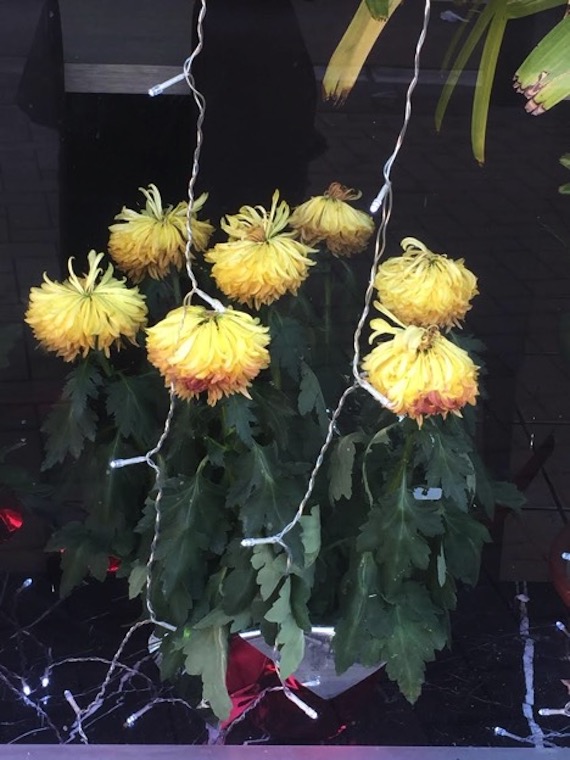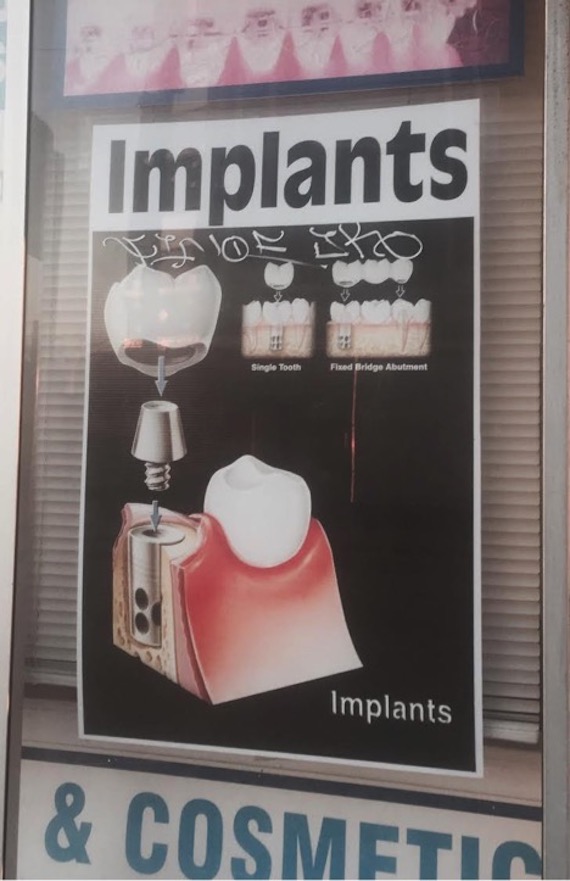
Patrick Cottrell and I spoke at length via email about his novel, his fascination with Thomas Bernhard’s houses, and the “grotesquely strange” human soul. For our correspondence, we agreed on a prearranged process: each message would be written after having taken a walk, and each message would contain an image. What follows are are the results.

Dear Patrick,
Before my walk today I put on a jacket I haven’t worn in ages because it’s 70 degrees in February — in Chicago. I detest the long winters here and relish this interjection of warmth, but I also can’t escape how obscene it is to enjoy this first wave of global warming. When I put on the jacket, in the pocket I found a fortune from last year. It says “You will be awarded some great honor.” And I thought, what an auspicious beginning to our conversation. Of course I am thinking of your novel, Sorry to Disrupt the Peace, and how each time I read the book it succeeds in both destroying me while making me laugh and my heart swells with empathy for Helen as she attempts to piece together the reasons behind her adoptive brother’s suicide. I’ve never read such a delightful yet devastating novel about suicide and loss. I would posit: I think Helen would hate the phrase “my heart swells” — she wouldn’t want it. I do think she wants to be seen, and she isn’t by her family. She is in her 30s, shares a cramped studio apartment in Manhattan with a roommate, and is estranged from her adoptive family. When her adoptive brother kills himself, her parents don’t reach out to her, they let her Uncle Geoff make the call and he emphasizes that no one expects her to come home for the funeral. She does return to Milwaukee, to seek out clues to her brother’s suicide, attempting to keep her grasp on the universe, it seems? She’s unhinged and, yes unreliable too, yet as I see it she’s perhaps the truest, sanest person in her family: unable or unwilling to play their games of social propriety, keeping up appearances, she’s blamed for not forging a connection. For her severity toward her family she was once called admiringly “a coldhearted bitch.” Perhaps this ability to tell the truth, or at least her truth, and cause (their) displeasure is where Helen is/was divergent from her adoptive brother?

Anne,
I like what you’ve said here. Thank you. I don’t know what’s the truth or insane or sane. I wrote the book in a state of feeling unhinged and uncertain about reality. Life was unraveling. In a way, it was the perfect moment to write a book. Or to begin writing.
Helen is a fairly resourceful character despite all of her flaws. Her investigation is about discovering the truth, but even that seems problematic, as if anyone can ever know the truth about a person’s life and death. I think that’s impossible, so the search itself is flawed. I can empathize with that choice though. She does the best she can considering the circumstances and who she is. That’s pretty admirable even if she’s kind of an asshole at times. Her brother is my favorite character though. He’s tender, delicate, and strong.
Right now I’m in the desert. It’s clearing to come out here. The plants are special. Two men just walked by me and one of them said, “It’s very Chinese.” I kind of hate overhearing other people’s conversations.

Patrick,
I love eavesdropping, the glimpses into other conversations, intruding on an intimacy you haven’t earned, briefly, then falling out. I like peering into windows of houses for the same reason, imagining how the lives within intermingle and part. Today I walked past a large modern structure under construction, the house looks like a series of connected boxes and has large desk in the front window — but from my vantage point the window appeared to contain another smaller, cozier house.
I have been thinking so much about houses and dwellings in relation to your book: what a house means to Helen’s adoptive parents, Helen’s own shared studio that her brother thought suited her, the homeless woman in Helen’s chapbook: “How to Survive in New York on Little to Nothing.” Helen admires doorways, and her brother too says he wants to keep doors shut — metaphorically. Can you talk about the houses in your book, what a doorway offers, the threat a door poses? What does one’s dwelling say about them? And also of your fascination with Thomas Bernhard’s house?

Anne,
The space of the house is one of inertia and avoidance. The furniture is off-putting, the rooms are suffocating and at the same time places of rest. No one in the house knows how to communicate with one another. I don’t know what the doors represent. It’s weird to talk about doors without thinking about the band The Doors. They’re not that cool, but when I was in high school I used to love them. A friend and I would try to smoke really gross weed and drive around and listen to them. What a recipe for disaster and trouble!
I was just telling a friend how sometimes I Google street view some of my houses from childhood. I walk around the neighborhood and look at the plants and trees. I have no idea if that’s normal or not. In my favorite house, which was in suburban Pittsburgh, I had my own bathroom. There was a skylight above the toilet. I always thought that was weird. It’s my favorite house because there I was the most miserable. Every day I can wake up grateful I don’t live on Wedgewood Drive anymore, so that’s kind of a gift.
I love looking at images of Thomas Bernhard’s houses in Austria, how their exteriors seem harsh and weird, like his writing. That mirroring between his houses and his writing appeals to me, maybe because I’ve been a lifelong renter, scrounging around for scraps to inhabit. You never saw where I lived in Brooklyn, but my bedroom was windowless, the walls were curved, there was a foot of space between the bed and these dressers that had been in the bedroom for years before we moved in. One day, I was cleaning behind them and I found a few bullets.

Patrick,
Childhood misery can become such an attachment. It’s a conundrum. I just saw that Whistler’s “Mother” is on view in Chicago — I was forced to stand in line to see it as a child, and when I actually saw it I thought people were crazy. It was so overrated, so muted. My first thought hearing of its current tour was disbelief that it’s still this thing — but also, that I want see it. Will I have a different experience? It was the first piece of art I detested.
Helen’s childhood misery is demonstrated as one long act of refusal. Makes me think of Bernhard’s misandry, but then also it’s Bernhard I think of with the balding European white male apparition. I sense an anxiety of influence but also of disconnect, that Helen isn’t his heir, can’t be. He may be Helen’s father’s wet dream but as the biological daughter of a Korean woman, there’s so much distance. The balding European man, too, is helpful in some way isn’t he? How do you see his role? What does Helen need? I’m also curious about writers you read as a child, and now, who are your influences/guides?

Anne,
I feel certain you will love that painting as an adult because it will remind you of that exact moment you realized it was possible to detest a piece of art.
I like what you’ve said about anxiety and disconnect. I tried to see clearly this balding European man, but from where he came or what’s his role, I can’t say. I don’t know. I think it’s okay to admit that. Brandon Shimoda linked his appearance to whiteness and suburbia. I think the European man could be an accumulation and materialization of those suburban experiences. But I don’t really know. For me, writing this book was about freedom. I wanted to work with a voice in which anything could materialize at any point. That freedom is the main thing that compelled me to continue on, even when I had trouble. So Helen is sitting on a chair, starting to freak out a little at her inability to communicate with her parents, and a balding European man appears. In my opinion, that’s perfectly reasonable.
Let’s see, when I was little I liked Anne of Green Gables. I related to her situation as an orphan and outsider. As an adult I’ve probably been the most influenced by my friends who are artists and musicians. Many of them live in Milwaukee and Chicago. I admire people who have figured out a way to navigate the madness of this world. Russell Westbrook, Bill Callahan, Jesse Ball, Fiona Apple, Renata Adler, Kara Walker, etc.

Patrick,
When put that way, I see the balding European man as a kind of proxy for Helen in her adoptive parents’ house, whether imagined, hallucinatory, or not, he is a needed (albeit aloof) companion in her investigation, and an injection of Western rationality. As in, he assures her there are clues and thus a logic behind her brother’s suicide. Though I guess there is, really: Helen discovers he orchestrated his death in a way that he didn’t engage in his life.
For me the suburbs surface in the blandness Helen’s brother attempts to hide behind: the white rice, the vanilla ice cream, the ways he hid his difference. I’m thinking too of lies he tells to appease: the interest in fly-fishing, the professor he told Helen he assisted. It’s generous and tragic, this denial. He’s very good at keeping secrets.
To me, Sorry to Disrupt the Peace is very much about navigating the madness of a world where more time and energy is spent in denying or mitigating the extent of its madness. Beauty lies in acknowledging this, and finding a way through it? I just saw Annie Baker’s adaptation of Uncle Vanya, and I was so relieved and frustrated to see Uncle Vanya fail at any attempt of ordering his life. It was cathartic. He couldn’t even hit, let alone kill, the man he took shots at! Helen’s adoptive brother is perhaps as forlorn as Vanya, but he has agency, and, well, he succeeds.
This navigating the madness of the world: is this process ever past tense? Perhaps the beauty of finding a way through it lies in showing that it’s possible? How is anyone supposed to live with anything? Helen asks this of Elena and now I ask it of you.

Anne,
The navigation of the madness of the world is endless. I agree with you, that Helen’s brother does have agency, and perhaps integrity, too.
I don’t know how anyone lives with anything. I do the best I can, but there are days I just want to zone out and watch the NBA and listen to Royal Trux and smoke a cigarette, if I smoked cigarettes, which I do not. I used to smoke a lot. I remember Jesse Ball suggested lucid dreaming an impossibly large cigarette, to cope with the effects of withdrawal.
In my opinion, the way through the madness is to see things clearly, to allow yourself to be surprised, and to have a sense of humor. Now that I’m looking at what I just typed, it sounds like advice for a marriage. Not that I’ve ever been married. Maybe another way to navigate the madness of the world is to not get married. This is what I’m thinking today. It might change tomorrow.

Oh, Patrick, I loved smoking too. I had my first cigarette on my 14th birthday; later that year I was caught smoking in the graveyard at school. As I recall my mother was pissed but amused — something in line with:
“The continuous work of our life is to build death.”
That’s Simone de Beauvoir quoting Montaigne in the opening line of her Ethics of Ambiguity, which I just started rereading. As soon I read the sentence I was struck by how it’s a defining tenet in STDTP.
And maybe life is like a long marriage? I feel like Helen needs new coping strategies, the waterfall coping strategy is soothing, but like bad self-help, the Fiona Apple coping strategy was perhaps more effective?
Your narrators can be so severe, abject and so gripping. I’m thinking of Helen, but also the narrator of your recent story in The White Review. I know you spoke of freedom being significant to writing the novel, but what draws you to a character?

Anne,
That quote from Montaigne reminds me of the Bernhard phrase from his novel Correction: “deathward existence.” A page after “deathward existence” appears, there is, “The question has always been only, how can I go on at all, not in what respect and in what condition.”
Out of context, that line seems dramatic, but when I came across it, I remember finding it dry and funny and serious.
In general, I am repulsed by my characters, and yet, I’m drawn to them, sometimes I even admire them. I like characters who are engaged with their world, their circumstances, their flaws. I have a fondness for neurotic and delusional humans, so why wouldn’t I write about them? I think my short stories are closer to poems and drawings in terms of content and form, rather than traditional short stories with fully developed characters and plots. I draw my short stories with thin, ugly, haphazard lines. So the characters themselves can be thin and flat. They stay the same, because there’s not enough space in the stories for them to change.

Patrick,
I’ve passed a number of sidewalk lending libraries during our exchange, and whenever I have I’ve peeked inside. Perhaps because I’m already thinking of your novel, I’ve been surprised by how the titles engage:
Twenty Things Adopted Children Wish Their Adoptive Parents Knew (I could see Helen’s adoptive parents having this book, but also it failing to bridge their distances)
Contribuer à votre succès (a French, bougier version of Helen’s guide: How To Survive in New York on Little to Nothing)
Esmé Wang’s The Border of Paradise (opening with a passage about never having known someone who killed themself, never having read a suicide note)
Franz Kafka’s Letters to Milena
This last book I took. Most of the correspondence is one-sided, Kafka’s letters published in a series without Milena’s responses. He writes of lung health and sanatoriums and Milena’s critiques of German spas. One of Milena’s essays in the appendix concerns whether letters of notable people should be published. She chastises those who are disappointed by artists lives —–“If you are disappointed by an artist, my dear girl, this is only because you haven’t understood how to find him, and don’t know how grotesquely strange the human soul is.”
The grotesque strangeness of the human soul! This is what you’re saying about character, no? I then thought of Egon Schiele, the way he conjures this too. Perhaps your work is neo-expressionist? It made me wonder, which books, which visual artists/movements do you feel your work shares an affinity with?

Anne,
I love Esmé Wang’s The Border of Paradise. You should go back to the sidewalk library and get it. Go, immediately! I’m excited for her next book, The Collected Schizophrenias on Graywolf.
I own Letters to Milena, but haven’t opened it. I don’t know if I’m afraid to, or what, but that line you’ve quoted makes me want to read it. It makes me sad that Milena’s responses do not exist. Isn’t that sad?
You’re right about the grotesqueness of the human soul. I like Egon Schiele. I don’t think I’d align my work with any artistic movements. I pick and choose the artists I like, disregarding time or movements. So I like Brueghel, Kara Walker, José Lerma, Glenn Ligon, Allison Schulnik, Mark Bradford, Tintoretto, etc.
I think my work has a lot in common with Tyson and Scott Reeder and John Riepenhoff, and many other artists from Milwaukee. They were all part of this scene at The Green Gallery, one of of my favorite places in the world. We would play basketball on the weekends and have dance parties in attics. All of this informs what I write about and how I see the world. There’s a lightness to what goes on at The Green Gallery. It’s never heavy-handed, it’s playful and fun. John Riepenhoff and his brother Joe were some of the first people who acknowledged me as a musician and artist. So I would align myself with them. Of course, I was a failure as an artist and musician, and that’s why today I write. But I’m in debt to them because they encouraged me to fail. And that’s a beautiful thing to do for another human, to encourage him or her to fail.
Painting by John Riepenhoff.








